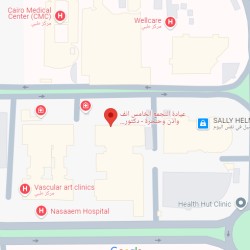What is Adenoid Surgery?
Do you suffer from breathing difficulties, especially while sleeping?
Do you make noises during sleep that disturb people around you?
Have you consulted a doctor who told you that you have a problem in your nose?
Don’t worry at all. The issue is usually simple – it could just be nasal polyps or adenoids that can be easily treated.
In this article, we provide a detailed explanation of nasal adenoids (causes – symptoms – treatment methods – side effects – and more).
Where Are Adenoids Located?
Nasal adenoids, also known as polyps, are abnormal growths or swellings of the mucous membranes that line the inside of the nasal cavity.
Causes of Adenoids
The nasal mucosa is a very moist tissue that protects the nose and sinuses from the inside. It also humidifies the air you breathe before it enters the respiratory system.
During infections or allergic reactions, the mucosa becomes swollen and red, and may produce fluids that drip outside the nose. Over time, this swelling can form small sac-like growths (polyps) that may block the nasal passages.
Common Triggers of Adenoid Growth
-
Acute sinus infections
-
Asthma
-
Allergic rhinitis (nasal allergies)
-
Cystic fibrosis of the nasal membranes
-
Churg-Strauss syndrome (a rare type of blood vessel inflammation)
-
Sensitivity to non-steroidal anti-inflammatory drugs (NSAIDs) such as ibuprofen and aspirin
Some people may also have a genetic predisposition that makes their nasal mucosa more reactive to infections, leading to the formation of polyps.
Symptoms of Adenoids
Adenoids are soft, painless growths that develop inside the nasal passages, most often in the area where the sinuses drain (around the eyes, nose, and cheekbones). Because they don’t have sensory nerves, you may not even realize you have them until they cause blockage.
When adenoids grow larger, they can block the nasal passages and lead to chronic nasal congestion.
Common Symptoms
-
Persistent nasal blockage
-
Runny nose
-
Postnasal drip that flows into the throat
-
Difficulty breathing through the nose
-
Chronic nasal congestion
-
Reduced sense of smell
-
Reduced sense of taste
-
Dry throat
-
Feeling of fullness in the ears
-
Mouth breathing
-
Facial pressure or headache
-
Itchy eyes
-
Fatigue
-
Snoring
-
Hearing loss (in some cases)
-
Sleep apnea (in severe cases)
-
Double vision (rare, in advanced cases with fungal sinusitis or cystic fibrosis)
Do Symptoms Differ Between Adults and Children?
Medical research confirms that symptoms of adenoids are almost the same across all age groups (children, adults, and infants).
How Are Adenoids Diagnosed?
Adenoids can usually be detected during a routine nasal examination by a doctor using a lighted instrument, such as a nasal or ear endoscope.
If the polyps are located deeper inside the sinuses, the doctor may need advanced imaging tests.
Diagnostic Tools
-
Endoscopy: A thin tube with a light and small camera is inserted to examine nasal passages and sinuses.
-
CT or MRI scans: Help identify the exact size and location of adenoids, and rule out other serious conditions such as bone deformities or tumors.
-
Allergy tests: To determine if chronic nasal inflammation is triggered by allergens.
-
Genetic testing (for children): Especially if cystic fibrosis or other inherited conditions are suspected.
Treatment of Adenoids
Treatment depends on the size of the adenoids, the severity of symptoms, and the patient’s age. In many cases, small adenoids that don’t cause significant symptoms may not require treatment.
Non-Surgical Treatments
Doctors usually start with medical treatments before considering surgery:
-
Nasal corticosteroid sprays: Help shrink adenoids and reduce inflammation.
-
Antihistamines: Useful when adenoids are related to allergies.
-
Decongestants: Reduce nasal swelling and congestion, but should not be used long-term.
-
Antibiotics: Prescribed if a bacterial infection is causing or worsening the symptoms.
-
Saline nasal irrigation: Helps clear mucus and relieve nasal blockage.
These treatments are usually effective in mild cases and may delay or even prevent the need for surgery.
Surgical Treatment: Adenoidectomy
If symptoms persist despite medication, or if the adenoids are causing serious complications, surgery becomes the recommended option.
Adenoidectomy is a procedure to remove the adenoids, performed under general anesthesia.
Indications for Surgery
-
Chronic nasal obstruction
-
Recurrent sinus infections
-
Breathing difficulties during sleep (sleep apnea)
-
Recurrent ear infections or hearing problems
-
Speech or facial growth issues in children caused by mouth breathing
Recovery After Surgery
-
Most patients go home the same day of the surgery.
-
Mild sore throat and nasal congestion may occur for a few days.
-
Full recovery usually takes 7–10 days.
-
Children often experience immediate improvement in breathing and sleep quality
Frequently Asked Questions About Adenoids
What are adenoids?
Adenoids are a mass of lymphoid tissue located at the back of the nasal cavity. They play a role in the immune system during childhood by fighting infections but usually shrink as a person grows older.
At what age do adenoids cause the most problems?
Adenoids are most active and problematic in children between the ages of 3 and 7 years. By adolescence, they often shrink significantly and rarely cause symptoms in adults.
Can enlarged adenoids shrink without surgery?
Yes, in some cases adenoids shrink naturally with age. Medications such as nasal sprays and antihistamines can also help reduce inflammation and improve symptoms without the need for surgery.
Is adenoid surgery painful?
Adenoidectomy is performed under general anesthesia, so the patient does not feel pain during the procedure. After surgery, mild discomfort, sore throat, or nasal blockage may occur but usually resolves within a few days.
Can adenoids grow back after removal?
In rare cases, adenoid tissue may regrow, especially if the surgery was done at a very young age. However, this is uncommon, and most patients do not experience regrowth.
How long does it take to recover after adenoid surgery?
Recovery usually takes about one week to ten days. During this period, patients should rest, avoid strenuous activities, and follow the doctor’s post-operative care instructions.
Do enlarged adenoids affect hearing?
Yes, enlarged adenoids can block the Eustachian tube, leading to fluid buildup in the middle ear. This may cause hearing problems, recurrent ear infections, or delayed speech development in children.
What is the difference between tonsils and adenoids?
Tonsils are located at the back of the throat, while adenoids are located higher up, behind the nose. Both are part of the immune system but serve slightly different roles. Unlike tonsils, adenoids are not visible through the mouth.


